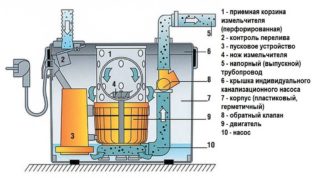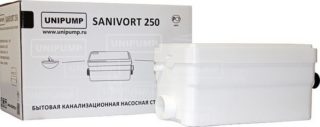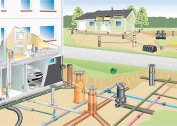The organization of drainage in the kitchen often causes difficulties. After household tasks, the water used changes the texture due to fat and food debris, which sooner or later leads to blockages. Even greater difficulties arise when planning the transfer of the sink or the whole kitchen. These tasks can be solved with the help of sanitary pumps.
Definition and scope
There are special devices designed to force the removal of sewage from plumbing or household appliances by creating excessive pressure. Such mechanisms are used in kitchens, bathrooms and toilets and are called sewage pumps or sanitary pumps.
To ensure the drainage of sewage by gravity, the pipes must have a diameter of at least 100 mm and lie at least 2 cm per meter. In many rooms it is difficult or impossible to fulfill these requirements. For example, if the kitchen is moved to the basement, the sewer line is higher than the room level. In such situations, sanitary pumps help. They create excess pressure and can grind the waste that comes up, which reduces the likelihood of clogging and allows you to remove wastewater regardless of the slope and diameter of the pipe.
Internal units and the principle of operation of sewage pumps
The device is a sealed container with holes for connecting pipes. Inside there is a submersible pump with a non-return valve, a filter system and a control element. The pump may also contain shredders.
When filling the tank, the control element starts the pump motor and chopping knives (if any). The liquid with crushed particles passes through the filter and enters the sewer due to overpressure. After pumping out all the liquid, the control element stops the engine. Filters are installed to eliminate unpleasant odors. The non-return valve is used to prevent the return of wastewater to the sink or household appliances.
A sanitary pump is used if:
- the need to use pipes of small diameter;
- the impossibility of observing a slope sufficient to drain water by gravity;
- Plumbing installations below the level of exits of sewer highways.
Shredding food debris and other waste reduces the risk of clogging.
Varieties of pumps for the kitchen
Pumps are classified by the following factors:
- the ability to move - stationary and mobile;
- temperature of the treated effluents - for warm and hot;
- engine cooling system - oil, water and air;
- type of pipe connection - vertical and horizontal.
Also, devices differ in power, performance, lifting height of effluents, dimensions and the number of connected pipes.
Depending on its characteristics, size and noise level, the pump can be installed directly near the sink or household appliance or in a separate room, for example, in a pantry or in a specially designated room.
Selection recommendations
Initially, the quantity and types of sources of effluents should be determined. The processed fluid temperature, pump power, the need for shredders and other features depend on this. If you plan to connect washing or dishwashers, you will have to install a pump that can handle hot water.The drains in the sink are considered cold, so you can get by with a device with a working temperature of 40-50 degrees.
If the kitchen is supposed to have more than one source of water, it is easier to put a device with several inputs than a separate pump for each drain. The required productivity also depends on the number of consumers. The more wastewater must be pumped out at the same time, the more powerful the pump should be.
The presence of a grinder is not required if the sewer drain is of a sufficiently large diameter or if there is such a device in the sink.
A pump with a vertical pipe connection can be placed directly under the sink.
Installation of a kitchen pump
Installing a sewage pump includes the following steps:
- choosing a place for the pump;
- power supply organization;
- installation of sewage;
- pump installation;
- connection of branches from liquid sources.
It is not necessary to call specialists to connect the device. You can cope with this task yourself by completing the following sequence of actions:
- disconnection of the tap from the sink;
- installation of a complete mounting bracket on the gasket;
- connection of the prepared branch and pump;
- connecting the pump to the sewer pipe;
- power supply.
 To connect a single sink, it is easiest to place the unit in close proximity. If there are several sources of effluents, the location of the pump must be chosen so that the connected pipes have a minimum number of bends and are located with an inclination of at least 3 centimeters per meter. Long bends should be provided with air valves to maintain pressure and prevent leakage of unpleasant odors.
To connect a single sink, it is easiest to place the unit in close proximity. If there are several sources of effluents, the location of the pump must be chosen so that the connected pipes have a minimum number of bends and are located with an inclination of at least 3 centimeters per meter. Long bends should be provided with air valves to maintain pressure and prevent leakage of unpleasant odors.
For high-power pumps, it is advisable to lay a separate wiring line with a residual current device. The connection of the pump and the riser is allowed only with hard plastic pipes, as corrugated or cast iron will quickly fail due to high pressure. The device must be installed on a smooth non-slip surface.
If you plan to install several pumps, a separate sewage must be installed for each. Air-cooled pumps require the installation of an air intake pipe. It will have to be laid vertically upwards from a special hole in the housing for 50-60 centimeters.
Reviews and prices
The simplest device for organizing the discharge of cold sinks will cost about 5000-7000 rubles. The price of a sewer pump with a grinder starts from 8000 rubles. Such devices are relevant for the kitchen in the apartment. The most advanced models that allow you to connect several sources and divert water to a height of 10 meters will cost 25-30 thousand rubles. Such costs threaten the owners of private houses and cottages located in the lowlands.
Reviews of the kitchen pump Grundfos Sololift2 S-3
- the ability to connect up to three sources, work with hot water;
- reliability, compactness and ease of maintenance;
- the presence of a chopper, the maximum level of tap - 6 meters.
Disadvantages:
- high price.
Sololift is useful for moving rooms with a large number of household appliances.
Unipump Sanivort 250 Kitchen Pump Reviews
- low price;
- connection of two sources;
- small dimensions.
Disadvantages:
- lack of choppers;
- maximum water temperature is 50 degrees.
SFA Sanivite Sink Sewer Pump Reviews
- the ability to connect to a source of hot water;
- low noise level;
- ease of maintenance;
- affordable price.
Disadvantages:
- connects to only one device;
- no choppers.
This model is suitable for drainage from a single kitchen sink.








